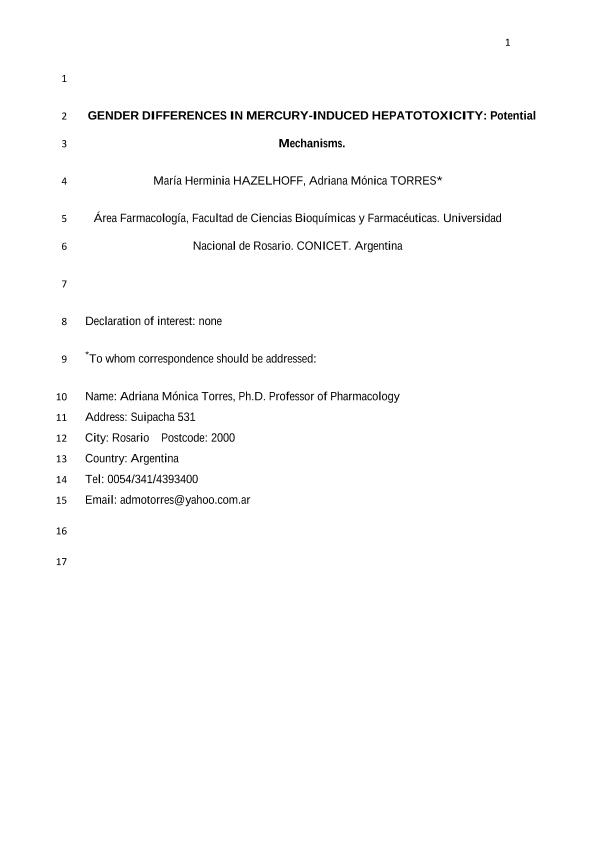Mostrar el registro sencillo del ítem
dc.contributor.author
Hazelhoff, Maria Herminia

dc.contributor.author
Torres, Adriana Monica

dc.date.available
2020-03-25T20:51:39Z
dc.date.issued
2018-07
dc.identifier.citation
Hazelhoff, Maria Herminia; Torres, Adriana Monica; Gender differences in mercury-induced hepatotoxicity: Potential mechanisms; Pergamon-Elsevier Science Ltd; Chemosphere; 202; 7-2018; 330-338
dc.identifier.issn
0045-6535
dc.identifier.uri
http://hdl.handle.net/11336/100820
dc.description.abstract
The accumulation of mercury in the liver causes hepatotoxicity. The organic anion transporter 3 (Oat3) and the multidrug-resistance associated protein 2 (Mrp2) are involved in the hepatic excretion of toxins and drugs and in the hepatic handling of mercury. The aim of this work was to study if there are gender-related differences in mercuric chloride (HgCl2)-induced hepatotoxicity in rats. Total mercury levels and protein expressions of Oat3 and Mrp2 in liver samples were also assessed to clarify the mechanisms underlying mercury-induced liver damage in male and female rats. Control and HgCl2-treated male and female Wistar rats were used. Hepatotoxicity was evaluated by plasma activity of transaminases and alkaline phosphatase, as well as by histopathological analysis. Oat3 and Mrp2 expression was assessed by immunoblotting. Female rats displayed a higher HgCl2-induced hepatotoxicity than male rats as demonstrated by the higher alterations in the plasma markers of liver damage and in the histopathology. The sex-related differences observed in the hepatic damage can be explained by the higher accumulation of mercury in liver from female rats. In this connection, after mercury treatment the expression of Mrp2 decreased in both sexes and the expression of Oat3 decreased only in males. The decreased in Oat3 abundance in the hepatocytes membranes in mercury-treated males would limit the uptake of mercuric ions into the liver protecting them from mercury hepatotoxicity.
dc.format
application/pdf
dc.language.iso
eng
dc.publisher
Pergamon-Elsevier Science Ltd

dc.rights
info:eu-repo/semantics/openAccess
dc.rights.uri
https://creativecommons.org/licenses/by-nc-sa/2.5/ar/
dc.subject
HEPATOTOXICITY
dc.subject
MERCURIC CHLORIDE
dc.subject
MRP2
dc.subject
OAT3
dc.subject
RATS
dc.subject
SEX DIFFERENCES
dc.subject.classification
Otras Ciencias de la Salud

dc.subject.classification
Ciencias de la Salud

dc.subject.classification
CIENCIAS MÉDICAS Y DE LA SALUD

dc.title
Gender differences in mercury-induced hepatotoxicity: Potential mechanisms
dc.type
info:eu-repo/semantics/article
dc.type
info:ar-repo/semantics/artículo
dc.type
info:eu-repo/semantics/publishedVersion
dc.date.updated
2020-03-10T13:06:03Z
dc.journal.volume
202
dc.journal.pagination
330-338
dc.journal.pais
Países Bajos

dc.journal.ciudad
Amsterdam
dc.description.fil
Fil: Hazelhoff, Maria Herminia. Universidad Nacional de Rosario. Facultad de Ciencias Bioquímicas y Farmaceuticas. Departamento de Ciencias Fisiológicas. Area Farmacología; Argentina. Consejo Nacional de Investigaciones Científicas y Técnicas. Centro Científico Tecnológico Conicet - Rosario; Argentina
dc.description.fil
Fil: Torres, Adriana Monica. Universidad Nacional de Rosario. Facultad de Ciencias Bioquímicas y Farmaceuticas. Departamento de Ciencias Fisiológicas. Area Farmacología; Argentina. Consejo Nacional de Investigaciones Científicas y Técnicas. Centro Científico Tecnológico Conicet - Rosario; Argentina
dc.journal.title
Chemosphere

dc.relation.alternativeid
info:eu-repo/semantics/altIdentifier/url/https://www.sciencedirect.com/science/article/pii/S004565351830523X
dc.relation.alternativeid
info:eu-repo/semantics/altIdentifier/doi/https://doi.org/10.1016/j.chemosphere.2018.03.106
Archivos asociados
